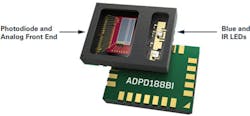Improved Smoke-Detection Devices Save More Lives
Download this article in PDF format.
One of the highest-volume products used in homes, commercial buildings, and factories is the smoke detector. Smoke detectors are mandated by government everywhere, so almost everyone has one. Literally hundreds of millions, maybe a billion, of them are installed around the world. Still, they’re missing from too many older homes and buildings.
The effectiveness of a smoke detector depends on the technology used, its placement in the home or building, and its power source. Now Analog Devices offers a whole new generation of detectors. The company’s ADPD188BI smoke-detector module significantly improves smoke detection and thereby can save more lives and property.
Sponsored Resources:
- EVAL-ADSMOKEKITZ Smoke Evaluation Kit
- ADPD188BI Integrated Optical Module for Smoke Detection
- Smoke Detection: A better way to design smoke detectors. A better way to save lives
Smoke Detector Operation
There are basically two types of smoke detectors: optical and ionization. The photoelectric or optical detectors consist of an LED to emit light picked up by a phototransistor receiver inside a small chamber that’s open to the surrounding environment. The phototransistor doesn't see the emitter directly, so the alarm is off. However, when smoke enters the chamber, it scatters the LED light and some of it strikes the phototransistor that triggers the alarm.
The ionization type of smoke detector uses some Americium-241 sealed into a chamber. Americium-241 is a radioactive element that emits alpha particles. The chamber also contains two plates with an applied voltage.
The Americium emits alpha particles that ionize the oxygen and nitrogen in the chamber, producing both positive and negative ions that are attracted to the plates. The result is current flow in the external circuit. If smoke enters the chamber, it neutralizes the ions and thereby decreases the external current flow. An electrical detector senses the change and sets off the alarm.
To date, most smoke detectors fall into the ionization category. Some say that the ionization type of detector responds faster to flaming fires. On the other hand, the optical type responds more quickly to smoldering fires. Also, optical versions are less susceptible to nuisance or false alarms. However, new designs like that from Analog Devices is making the photoelectric type more effective and competitive. An additional benefit of the photoelectric approach is lower cost.
We Need a Better Smoke Sensor
Analog Devices’ new ADPD188BI optical sensor IC will trigger a smoke alarm sooner. It’s made up of two LEDs—one a 470-nm blue LED and other an 850-nm infrared plus two photodiode detectors (see figure). By using two light wavelengths, the detector can better sense smoke from different types of sources, allowing it to better differentiate between true and false alarms. This integrated circuit also includes four amplifiers, bandpass filters, and integrators, plus a 14-bit ADC, LED drivers, and I2C and SPI digital interfaces.
Furthermore, the company developed a special smoke chamber optimized for best detection results with the ADPD188BI IC. This part of the module also helps block ambient lighting that can result in a false alarm.
Paying Attention to Regulations and Certifications
Smoke detectors are highly regulated—global standards have been established to ensure stated specifications and performance goals. All smoke detectors must be tested to achieve the certification that validates their performance. The primary standards that must be met include:
U.S. and Canada:
- UL268 Smoke Detectors for Fire Alarm Systems
- UL217 Smoke Alarms
Europe:
- EN14604 Smoke alarm devices
- BS EN 54 Fire Detection and fire alarm systems
International:
- ISO 7240 Fire detection and alarm systems
Recently, the Underwriters Laboratory (UL) has put forth new versions of the UL-217 and UL-268 standards that consider the significant improvement in photoelectric smoke detectors. When using the ADPD188BI, a new smoke detector can readily pass the UL tests.
Speeding Up Development
Analog Devices offers a complete smoke-detection evaluation package called the EVAL-ADSMOKEKITZ. Its contents include the EVAL-ADPD188BIZ-S2 integrated optical, module with smoke chamber, an alternate smoke chamber designated EVAL-CHAMBER, and the EVAL-ADPDUCZ, a microcontroller board that supports the detector IC. This kit facilitates and expedites the development of any new smoke-detector product.
Sponsored Resources:
About the Author

Lou Frenzel
Technical Contributing Editor
Lou Frenzel is a Contributing Technology Editor for Electronic Design Magazine where he writes articles and the blog Communique and other online material on the wireless, networking, and communications sectors. Lou interviews executives and engineers, attends conferences, and researches multiple areas. Lou has been writing in some capacity for ED since 2000.
Lou has 25+ years experience in the electronics industry as an engineer and manager. He has held VP level positions with Heathkit, McGraw Hill, and has 9 years of college teaching experience. Lou holds a bachelor’s degree from the University of Houston and a master’s degree from the University of Maryland. He is author of 28 books on computer and electronic subjects and lives in Bulverde, TX with his wife Joan. His website is www.loufrenzel.com.

